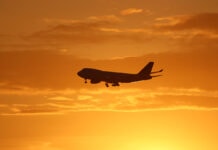 Experts predict this holiday season will set records for volume of travelers. Here’s how airlines are planning to avoid the holiday air travel disruptions that plagued travelers last year.
Experts predict this holiday season will set records for volume of travelers. Here’s how airlines are planning to avoid the holiday air travel disruptions that plagued travelers last year.
Air travel is predicted to soar this winter. The question is, will air travel disruptions also take wing?
As Nick Calio, CEO of Airlines for America, said on “Good Morning America” recently, when it comes to air travel, “This is shaping up to be a record-setting year.” In fact, almost 3 million people flew in a single day in the U.S. over the Thanksgiving holidays, according to the Transportation Security Administration (TSA), and it looks like those numbers will only increase.
John Heimlich, an economist for Airline for America (formerly Air Transport Association), agreed, telling The LA Times, “I’m optimistic that what we saw over Thanksgiving is emblematic of the kind of demand we’ll see this winter.” The demand, he added, “is going to be very strong.” This jibes with AAA’s projection, which as of Dec. 11 was that 7.5 million people will take to the airways between Dec. 23 and Jan. 1, 2024, an almost 5% increase over last year.
Does this mean that we’re in for another air travel meltdown like we saw this time last year, when Southwest Airlines had to cancel 16,000 flights and strand 2 million passengers across the U.S. due to complications of a massive blizzard? While no one can guarantee a big storm won’t cause a U.S.-wide air travel snow-snarl, flight cancellations are down this year so far by 1.3%. However, delays are up slightly from last year, and are 4% higher than in pre-pandemic times.
Airlines say they are ready to take on this year’s winter travel crowds by ramping up staffing and slimming down their scheduling, adding more winter-weather aides such as deicing trucks. However, the air traffic control towers that help guide flights are still facing a staffing shortage, and weather is always a factor, especially with this year’s active El Nino pattern that can amp up storms throughout the U.S.
Southwest said it is working to avoid repeating last year’s debacle with a three-part plan that includes adding more staff and weather-related equipment to cold-weather airports, investing in better technology and improving staff communications.
Though Southwest experienced the worst of the worst last year, other airlines also had their share of delays and cancellations. But they’re also working on it. Overall, Rachel Coleman, Senior Editor at Easy World Travels told AARP, “Airlines are more prepared this year with backup plans and processes to handle any potential disruptions.”
This includes better systems to communicate with passengers should a problem occur with their flight, improved weather forecasting technology. For example, American has introduced a computerized Hub Efficiency Analytics Tool to help keep operations on pace even in bad weather conditions. United also has rolled out its Connection Saver algorithm, which informs passengers when it looks like they might miss a connection and maybe even allow the flight to wait. United also has added 13,000 more pilots, flight attendants, ramp workers and customer service agents, with plans to add a couple thousand more by the end of the year.
When it comes to weather or another problem that is outside of the airline’s control, you are entitled to a full refund. If you — or your keynote speaker — do get stuck en route to your event due to an airline-controlled problem such as maintenance or crew problems, most U.S. airlines will rebook you on the same airline for no additional charge, and several, including America, Delta, JetBlue and United, will rebook you on a partner airline for no additional cost. And almost everyone will provide a meal voucher or cash if you have to wait three hours or more for a flight.
The U.S. Department of Transportation offers an Airline Customer Service Dashboard that outlines what each of the U.S. airlines offer to passengers who, despite everyone’s best efforts, end up experiencing significant flight disruptions due to circumstances within the airline’s control.
You May Also Be Interested In…
More Planes and Passengers Than Ever Expected to Fill the Skies in 2024










